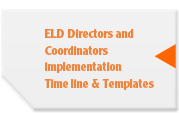Carousel Assessment Overview
(see Carousel Teacher's Guide page 32-33 for details)
End-of-Chapter Testing
- Option 1: Use the formal end-of-chapter tests in the Carousel Testers (grades 2-5) or the Carousel Testers (grades K-1). The Carousel Tester Examiner's Manuals provide information about test administration, scoring rules, answer keys, implications for instruction, and other helpful information. Learn more.
- Option 2: Use the informal end-of-chapter listening and speaking interview (outlined in the Teacher's Guide) and the reading and writing test in the Resource Book. Learn more.
Reading and Writing Chapter Pre-Tests and Post-Tests
Students are given a reading and writing pretest at the beginning of each chapter in Units 2-8 to measure their knowledge of the target vocabulary and concepts before instruction begins. The chapter pre-test enables teachers to pinpoint students' strengths and weaknesses and adjust their instructional plan accordingly. The pre-tests also give teachers baseline information so that they can measure the progress students make before and after the chapter instruction. At the end of each chapter, students take the reading and writing chapter post-test. The chapter pretest/post-test is located in the Resource Book.
Chapter Overviews & Evaluation Checklists
- Found at the beginning of every chapter
- Outlines the learning objectives for each lesson in the chapter: Listening, Speaking, Reading, and Writing
- Use these objectives to track each student's progress and to measure how well students are meeting the objectives
- Available as reproducible blackline masters in the Resource Book
- View sample
"Observing Student Progress" Sections
- Learning objectives for each lesson listed at the end of the lesson to remind teachers to stop and evaluate students' progress
- Ask yourself, "Do students meet these key objectives?"
- If students did not grasp a concept presented, review and reinforce
- View sample
Portfolio Evaluation
- Students create and compile a portfolio of work they complete for each chapter
- Shows what students are doing well and areas that need attention
- Serve as a body of evidence to demonstrate that content standards have been met
- At the end of a chapter, students choose three pieces that demonstrate their best work
- Evaluate students' portfolio using Assessment Form 2 found in the Resource Book
- Portfolios are rated: Superior, Average, Below Average, and Fails to Meet Objectives
- View Sample
Unit Evaluation
- At the end of each unit, evaluate each student's overall performance for that unit
- Assess the following criteria:
- Mastery of chapter objectives
- Ability to work with others
- Ability to work independently
- Completion of assignments neatly, accurately, and on time
- Listening & speaking performance evaluations
- Reading & writing chapter tests
- Portfolio evaluations
- Use Assessment Form 3 found in the Resource Book
- If student scores "superior" or "satisfactory" in all categories, move to the next unit. However, if the student scores "not satisfactory" in any category, provide additional instruction and practice to prepare him or her for the next unit.
- View Sample
| Assessment Purpose | Test Type |
|---|---|
| Placement | 1. Use a formal language proficiency test (e.g., state ELP test, IPT Oral Test)
(see Carousel Teacher's Guide page 28 for details) |
| Monitoring Progress | "Observing Student Progress" Sections
|
| Formative Assessment | Chapter Overviews & Evaluation Checklists
Portfolio Evaluation
Unit Evaluation
Language Progress Card
|
| Summative Assessment | End-of-Chapter Testing
|
Listening and Speaking Performance-Based Assessment.
In this performance-based assessment, individual students and/or small groups are asked to perform various listening and speaking tasks that demonstrate understanding of the target vocabulary and concepts that were presented in the chapter. It is recommended that teachers evaluate each student's performance using Assessment Form 1 ("Listening and Speaking Evaluation Form"?), found in the Resource Book.



